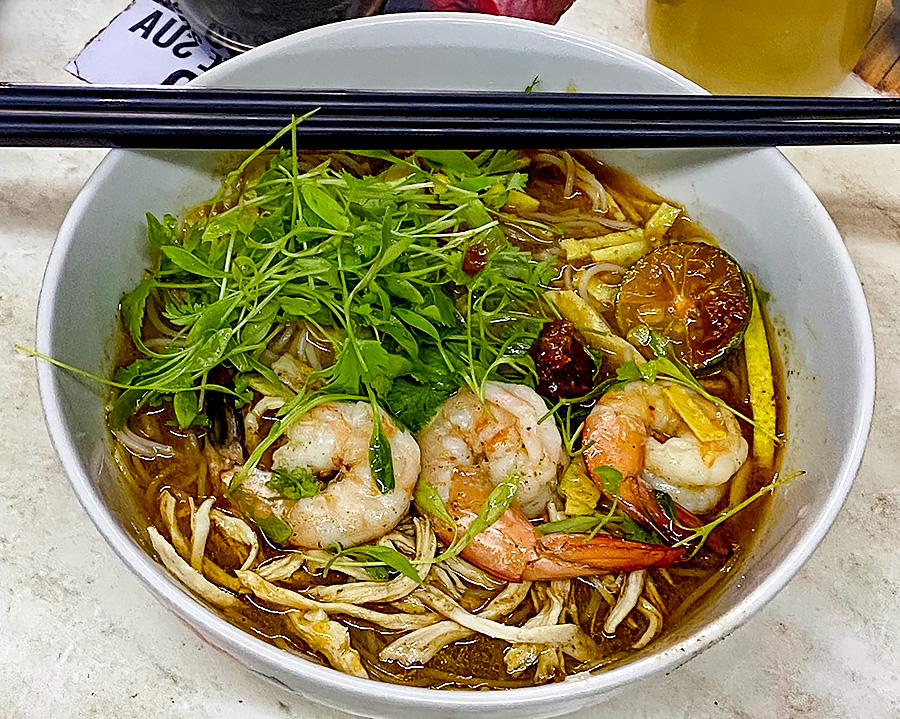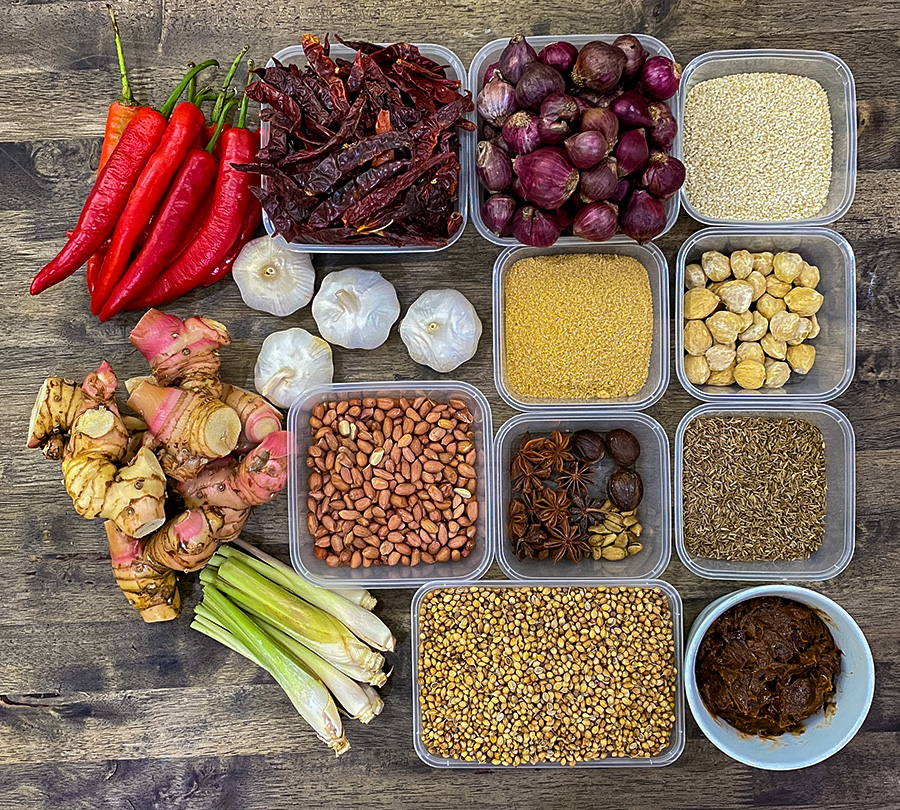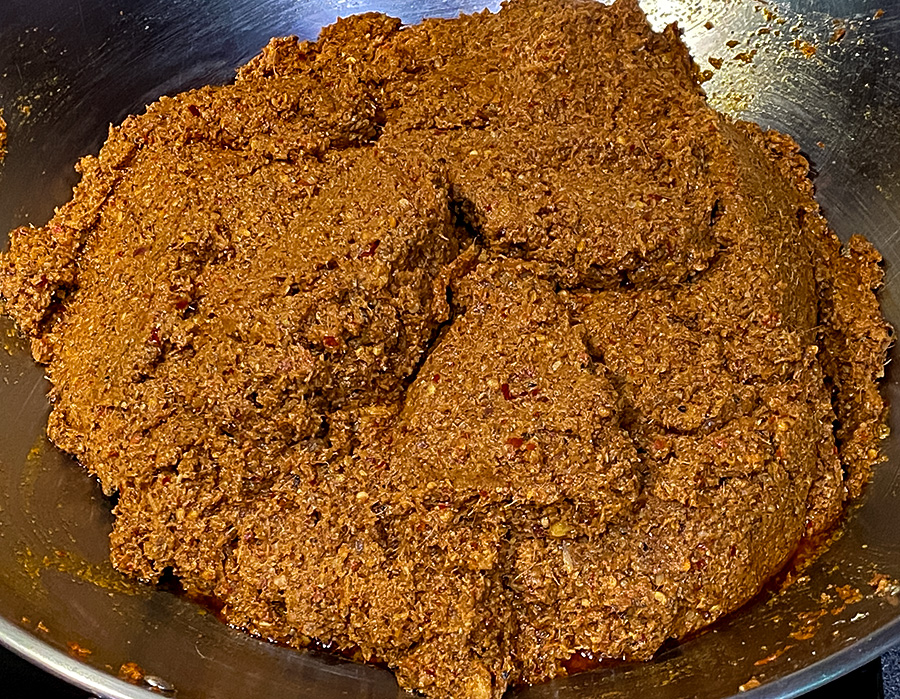|
Clem's Kuching Laksa Paste |
|||||||||||||||||||||||||||||||||||||||||||||||||||||||||||||||||||||||||||||||||
|
|
|||||||||||||||||||||||||||||||||||||||||||||||||||||||||||||||||||||||||||||||||
|
And then there is the singular laksa which is found in Kuching. I use the adjective "Kuching" with this laksa for a couple of reasons: (i) it is a dish for which the recipe quite certainly originated in Kuching, Sarawak in early post-WW2; (ii) it is also called "Sarawak Laksa" (erroneously in my view) but again, the taste and outcomes of this product where offered, varies and is never much like the Kuching product.
Even in Kuching, the laksa cognoscenti will tell you that there is a great variation in taste and looks of Kuching laksa. For me, there are two general kinds of Kuching laksa: One with a distinct curry flavour and one without. The laksa which is not redolent of curry is the genuine product.
Laksa is cooked using a paste which is rarely prepared in home kitchens. This is because the recipe for this paste has been closely guarded since its inception, plus it is rather involved to make it. The paste is usually bought from a commercial source and there are many brands (and therefore tastes) available nowadays.
My preferred brand of paste is no longer available and it was made by who is thought to be one of the original purveyors or originators of Kuching laksa. This was the Tan family who lived at Kim Keat Road where their paste was made. But their legend now lives on through one of the sons who continues to make the paste to the old recipe: It is available in Kuching (and mail order) as the "Barrett's" brand (Barrett being the name of the son).
Nowadays, it is possible to find some recipes for Kuching laksa on the web but it is not easy to know which one results in a good (or authentic) outcome. I first came across a recipe in November 2011 when 3tummies published "the secret of Sarawak laksa paste revealed". I cross-referenced this recipe with others found online (most of which seem to be based on the 3tummies version) and found that the 3tummies recipe omitted an important spice: fennel. Further, it looked like it probably had an over abundance of coriander. I decide to make up my own formulation based on my research. The latter is based on what I imagine the flavour profile should be like from decades of enjoying Kuching laksa.
|
|||||||||||||||||||||||||||||||||||||||||||||||||||||||||||||||||||||||||||||||||
|
|
|||||||||||||||||||||||||||||||||||||||||||||||||||||||||||||||||||||||||||||||||
|
Method
|
|||||||||||||||||||||||||||||||||||||||||||||||||||||||||||||||||||||||||||||||||
|
|
|||||||||||||||||||||||||||||||||||||||||||||||||||||||||||||||||||||||||||||||||
|
After the dry spices are combined with the fresh ingredients. |
|||||||||||||||||||||||||||||||||||||||||||||||||||||||||||||||||||||||||||||||||
|
|||||||||||||||||||||||||||||||||||||||||||||||||||||||||||||||||||||||||||||||||
|
|||||||||||||||||||||||||||||||||||||||||||||||||||||||||||||||||||||||||||||||||
|
|
|||||||||||||||||||||||||||||||||||||||||||||||||||||||||||||||||||||||||||||||||
|
This is an oily paste. Those who are averse to the quantity of oil may (i) use a "healthier" oil, or (ii) remove the oil after frying and prior to preparing the laksa dish. Do remember that the oil will contain a lot of the flavours of the paste.
|
|||||||||||||||||||||||||||||||||||||||||||||||||||||||||||||||||||||||||||||||||
|
|
|||||||||||||||||||||||||||||||||||||||||||||||||||||||||||||||||||||||||||||||||
|
Cooking Kuching laksa involves taking an appropriate amount of paste simmered in a hearty, meat bone or seafood broth (or use chicken stock powder or bouillon cube) and then sieving to remove the paste insolubles after some minutes (do not over do the simmering as it will change the flavour profile; 30 minutes of infusion should be sufficient).
Coconut milk is added to the laksa broth prior to it being ladled over rice vermicelli and some blanched bean sprouts. Cooked prawn, shredded chicken, sliced fish cake, and sliced thin egg omelette are placed on top of the rice vermicelli. It is often garnished with coriander sprouts and served with a belachan paste accompanied by a wedge of calamansi lime. My version of the belachan paste for laksa may be made thus:
Delicious!
|
|||||||||||||||||||||||||||||||||||||||||||||||||||||||||||||||||||||||||||||||||
18 April 2023
Created by Clem Kuek






